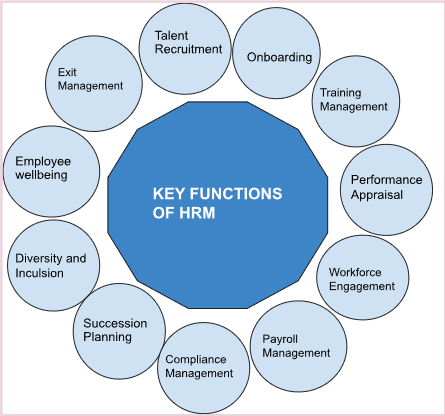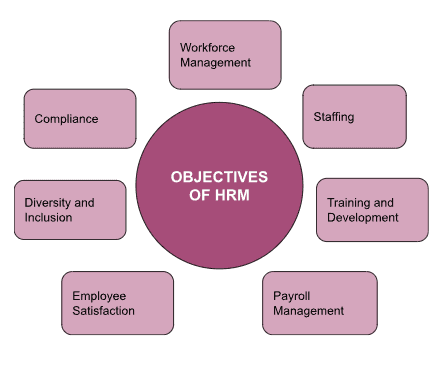Top 11 Key Functions of an Human Resources Management (HRM) in 2023
What is HRM?
Human Resource Management (HRM) is a strategic method that firms use to efficiently manage their workforce. HRM's mission is to align the workforce with the overall goals and objectives of the organization, utilizing various policies, practices, and processes to guarantee that the workforce is motivated, skilled, and productive. Human resource management functions include recruiting, selection, training and development, remuneration, performance management, and employee relations. Human resource management is also concerned with legal compliance, diversity and inclusion, and workplace safety. HRM plays a critical role in managing people and achieving organizational requirements by establishing the organization's culture, encouraging employee engagement and happiness, and contributing to the organization's success.
What are the functions of HRM?
Human resource management (HRM) refers to the processes and activities that a company uses to successfully manage its employees. HRM's primary functions include recruiting and selection, training and development, salary and benefits, performance management, and employee relations. These functions include everything from locating and attracting qualified candidates for job openings to managing employee-employer relationships. HRM also guarantees that employees' requirements are met and that their experience is favorable, from monthly payment through the full and final settlement of people departing the firm. HRM contributes to a motivated, skilled, and productive staff that is aligned with the organization's goals and objectives through carrying out these functions.
Let’s take a look at the key functions of HRM:

1. Talent Recruitment: One of the most significant responsibilities of HRM is talent hiring, which entails discovering and choosing eligible applicants for employment roles. Creating job descriptions, advertising job opportunities, sourcing people, assessing resumes, conducting interviews, and selecting candidates are all part of the process. HR managers must guarantee that the recruitment process is efficient and successful, and that the best candidates for the job are attracted and hired.
2. Onboarding: The process of welcoming and integrating new employees into the organization is known as onboarding. Completing new hire paperwork, delivering orientation, introducing the new employee to the company, and defining expectations are all part of the process. HR managers must ensure that new workers feel welcomed and supported during the onboarding process.
3. Training Management: The HRM training management function is critical for increasing employees' skills and knowledge, which can lead to improved performance. HR managers are responsible for identifying training needs, designing and developing training programs, and delivering training sessions. Human resource managers must ensure that training programs are successful and suit the needs of employees and the organization.
4. Performance Appraisal: Performance appraisal is the process of reviewing and delivering feedback to employees. Setting performance goals, holding performance reviews, and generating performance improvement strategies are all part of the process. Human resource managers must ensure that the performance appraisal process is fair, effective, and connected with the goals of the firm.
5. Workforce Engagement: The HRM task of managing relationships between workers and companies is known as "workforce engagement." Employee participation must be encouraged, employee concerns must be addressed, and management and employee communication must be facilitated. Managers of human resources must make sure that there is a supportive and appreciated company culture.
6. Payroll Management: Payroll management is the part of HRM responsible for overseeing the salaries and benefits of employees. Payroll laws and regulations must be followed, and HR managers must make sure the payroll process is accurate, effective, and compliant. Managers of human resources must also make sure that workers are paid fairly and provided enough benefits.
7. Compliance Management: The role of HRM that ensures that the organization complies with labor laws, rules, and policies is known as compliance management. HR managers are responsible for ensuring that the organization has accurate records, monitors compliance, and addresses compliance issues.
8. Succession Planning: The function of human resource management that involves identifying and developing possible candidates for leadership roles within the organization is known as succession planning. HR managers must build career development plans, provide training and coaching, and assess employees' suitability for leadership positions. Succession planning contributes to the organization's robust leadership pipeline.
9. Diversity and Inclusion: Diversity and inclusion is a function of human resource management that entails promoting a varied and inclusive workplace culture. Employee resource groups and diversity training programs are examples of policies and programs that HR managers must develop and implement to encourage diversity and inclusion. Human resource managers must ensure that the workplace culture is friendly and that employees feel appreciated and included.
10. Employee Wellbeing: Employee wellness is an HRM function that promotes employee health and well-being. HR managers must develop wellness programs, provide mental and physical health services, and handle workplace safety problems. Employee wellness programs can aid in the improvement of employee health, the reduction of absenteeism, and the growth of productivity.
11. Exit Management: Exit management is the function of human resource management that deals with the departure of personnel from a company. HR managers are responsible for conducting exit interviews, managing the offboarding process, and ensuring legal and ethical compliance. Exit management is beneficial.
Managerial functions of HRM:
HRM managerial functions include planning, organizing, directing, and regulating an organization's human resources in order to achieve its goals and objectives. These functions include:
1. Planning: This job entails studying and identifying the organization's human resource needs, both in terms of number and quality. HR managers must estimate future human resource demand and supply and devise measures to fill any gaps. Developing recruitment strategy, succession planning, and staff planning are all part of this.
2. Organizing: After identifying the human resource requirements, the HR manager must organize the workforce to ensure that the right people are in the proper places. This includes developing job descriptions and specifications, as well as building job structures and hierarchies.
3. Directing: Directing is the process of leading and inspiring personnel to achieve the goals of the firm. Creating a great work atmosphere, providing feedback and reward, and encouraging employee involvement are all part of this.
4. Controlling: Controlling entails monitoring and analyzing workforce performance and taking corrective action as needed. Implementing performance management systems, conducting employee surveys, and analyzing HR metrics are all part of this.
Overall, human resource management managerial functions are crucial for ensuring that the organization's human resources are successfully managed and aligned with its overall goals and objectives. Human resource planning, organization, direction, and management that is effective can lead to enhanced productivity, improved employee morale, and, ultimately, better business results.
What are the objectives of HRM?

Human resource management (HRM) objectives include:
1. Workforce Management: This HRM goal entails managing the entire employee lifecycle, from hiring through separation. Talent acquisition, onboarding, training, performance management, and succession planning are all part of it. The ultimate purpose of workforce management is to guarantee that the organization has the proper personnel to accomplish its business objectives and goals.
2. Staffing: The process of identifying, attracting, and choosing the best people for job openings is referred to as staffing. HRM's goal entails writing job descriptions, advertising job openings, assessing resumes, interviewing candidates, and making employment offers. The primary goal of staffing is to guarantee that the company has a competent workforce capable of achieving its goals.
3. Training and development: HRM attempts to improve employees' job performance and career growth by developing their skills and knowledge. This includes creating and implementing training programs, providing mentorship and coaching, and giving opportunities for growth and learning. The goal of training and development is to provide people with the skills and information they need to do their jobs well and advance in their careers.
4. Payroll Management: This HRM goal entails managing employee salary and benefits. It includes developing wage structures, calculating employee salaries and bonuses, managing employee benefits such as health insurance and retirement plans, and assuring tax compliance. Payroll management's primary purpose is to ensure that employees are adequately reimbursed for their efforts.
5. Employee Satisfaction: This HRM goal entails managing employee relations and ensuring employees are content with their work environment. Employee involvement, dispute resolution, and performance management are examples of such activities. Employee settlement is to foster a healthy work environment in which employees feel appreciated, respected, and driven to do their best.
6. Diversity and Inclusion: Human resource management strives to foster workplace diversity and inclusion. This includes building programs to attract and retain diverse personnel, as well as putting in place rules that promote inclusivity. The goal of diversity and inclusion is to guarantee that the company reflects the community it serves and that all employees are treated fairly and with respect.
7. Compliance: This HRM goal entails making sure that the company complies with all applicable employment laws and rules. To do this, policies and practices must be created and put into effect that adheres to all applicable laws, including those pertaining to equal employment opportunity, health and safety, and labor. Compliance's primary objectives are to safeguard the company from legal liability and to develop an environment that is fair and safe for all workers.
Conclusion:
In conclusion, human resource management (HRM) is essential for properly managing an organization's workforce, from hiring and selecting employees to handling their departures. HRM helps to create a workforce that is motivated, competent, and productive by coordinating the workforce with the organization's goals and objectives. In addition, HRM makes sure that the company abides by the law, supports diversity and inclusion, and gives workers a safe and healthy workplace.
HR managers must be able to implement successful HR policies, practices, and procedures in addition to having a thorough understanding of HRM's fundamental duties. By doing this, HR managers may assist businesses in finding and keeping top talent, advancing the education and training of staff members, and fostering a healthy workplace environment.
HRM is the key to realizing the potential of an organization's workforce's potential, which ultimately determines an organization's success. Organizations may ensure they have the appropriate people in the right places, with the right skills and motivation, to achieve their goals and objectives by concentrating on the crucial HRM functions and adopting a strategic approach.